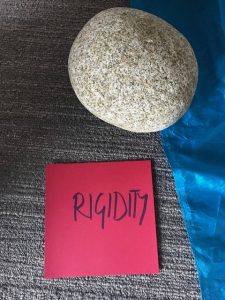What does it feel and look like to be in a state of Wellbeing? The recent retreat that I facilitated with my colleague Karla Brodie was based around this inquiry. One of my favourite ‘Wellbeing’ models is the one offered by the psychologist Daniel Siegel, author of many books including ‘Mindsight’. For him it is defined by a healthy and balanced mind state that needs to be:
Flexible, Adaptive, Coherent, Energized, and Stable. (using the acronym FACES)
When these qualities are in place there is an integrated flow through daily life that he describes as a “River of Wellbeing”. Living by the above qualities will keep you afloat, even when choppy or unchartered waters arise. Once these qualities fall out of balance you will move to one of the banks on either side of the river which in his model are represented by chaos and rigidity. In a state of chaos there’s too much movement and with rigidity the flow becomes stagnant. The flow of the river needs to be just right in order to feel an integrated state of Wellbeing.
Of course this state is not something to achieve once and then it’s done. It’s a constant response and checking in with yourself and may need to be balanced out when you are in one opposite by cultivating a bit of the other side of the river bank. In a similar way the ancient system of Yoga recognises these energies through the Gunas. They are the cosmic energies that pervade all nature, including our bodies and minds. They reflect the polarities; with one pole that’s static, a second that is active and a third that is a point of balance. We can map the gunas onto the model of the River as you can see we made a model of this at the retreat.



There are 3 Gunas.
TAMAS: Inertia or lack of movement; a quality that can be described as resistant to change, apathy, ‘feeling stuck’, lethargic, lazy, tired, clouded, dull, heavy ..and could be seen as the energy of the past. In the nervous system it might be the ‘freeze’ or ‘play dead’ response. Hypoarousal.
RAJAS: Activity, change, evolution and development; could be fire energy with grasping, desire, wanting, attachment, competition…and could be seen as thinking about the future. In the nervous system it might be the ‘fight or flight’ response. Hyperarousal.
SATTVA: A point of balance between Rajas and Tamas. The qualities of balance, clarity and light. A feeling of peace and harmony, a sense of being enough, doing enough and having enough. A feeling of presence. Homeostasis.
We are all always vacillating between Rajas, Tamas and Sattva. And we do this on a physical, energetic, emotional, mental, relational or spiritual level. The Maori model for Wellbeing known as ‘Hauora’ also acknowledges that the state of integration and balance needs to happen across all of these layers of being human – physical, mental, spiritual and very importantly through relationship within family and community.
Yoga philosophy and practice can provide you with a way of meeting all of the koshic layers so that you can remember a sense of Well-being in every moment; a pure state of presence where you are no longer affected by the past or worrying about the future but are instead united with the here and now, a Sattvic state. Through the practices of Yoga you are offered tools that will help you to notice what state you are in and then make choices as to how best to meet whatever is arising in any given moment. It’s important not to reject Tamasic or Rajasic state. Tamas energy is needed for resting and sleeping or bringing things to a full stop. Rajas is vital for getting out of bed in the morning. But sometimes these energies are present in a way that goes against the flowing sense of Wellbeing, spending to much time in Tamas could indicate that the Nervous System has gone into ‘Freeze’. A predominantly chaotic approach to life may indicate that the Fight or Flight response has been triggered. Do not judge yourself when you are out of balance but rather welcome and listen to what messages may be waiting to be heard. Cultivating the art of listening inwardly, to start a conversation with your body and what’s arising is vital if you are to find the integrated Sattvic state.
A useful reflection is to ask yourself which side of the River you spend most of your time on. By acknowledging and seeing the predominant energy that is ruling your life you may get some insight as to what kinds of practices and activities might be useful to get you sailing down the middle of the river again.
Questions for Reflection:
Where in my life is there a sense of heaviness or inertia? What movement is required to wake this part of me up?
What parts of my life are ruled by Chaos? Through what activities could I bring more stillness and rest?

